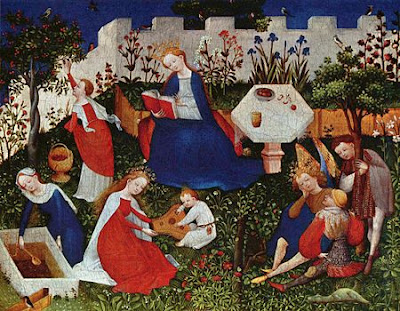 |
Emilia in the rosegarden (Teseida)
Giovanni Boccaccio
c. 1460 |
What is the first thought that comes to mind when you think of a garden? Is it a Zen garden in the East, with sand and serenity humbling the area? Is it in your yard, where vegetables sprout for you to pick when they're fully grown?
Or do you find yourself thinking of the more biblical representation, the Garden of Eden, where Adam and Eve fell to the snake's temptations?
Whatever your first thought may be, what is most important to know is that a garden is generally defined as a piece of land dedicated to the growing of plants. In the Middle Ages, however, a garden often took on a stronger role of symbolism.
The Enclosed Garden
 |
Roman de la Rose
c. 1490-1500 |
While a garden was certainly used to cultivate flowers and food, in Medieval time they had another purpose as well. Known as an
enclosed garden, or
hortus conclusus, these gardens had many names. Some referred to these spaces as
pleasure gardens, or a 'pleasance' or 'herber,' due to what was contained within. Enclosed by walls, and often built as an extension of noble houses, these spaces were meant for relaxation.
The physicality of the space invited people to spend time in them, as they would often be decorated with raised beds surrounded by flowers, topiary, fountains, and decorative pots (1). The most extravagant of gardens would have a pool, orchard, or even an aviary. A similar example would be the Palace of Versailles, which has sprawling gardens that can easily be compared to a medieval enclosed garden.
However, enclosed gardens were not exclusive to wealthy homes. While they were smaller, these gardens existed in the courtyards of monasteries, where monks would use the garden for herbs and medicinal plants (2). Hospitals were also had these spaces, which "relied on the materiality of their cultivated walled
gardens to offer both contemplative and restorative physical space for the
religious and the sick" (3).
History
 |
Madonna and Child
Bernardino Luini
c. 1500-1510. |
So, where did the idea of enclosed gardens even begin? Where did they get their name?
As they are tied closely with religion, which will be touched on further down, the origins of enclosed gardens begin in the Song of Soloman - also known as the Bible's Song of Songs. The term for enclosed gardens, hortus conclusus, first appears in 4:12 - "Hortus conclusus soror mea, sponsa, hortus conclusus, fons signatus" (A garden enclosed is my sister, my spouse; a garden enclosed, a fountain sealed up) (4).
From this, artists began to depict enclosed gardens in art, incorporating images of The Virgin Mary in a way that would display her immaculate purity.
Interestingly enough, this meant that these depictions of enclosed gardens popularized them enough to push people into actually building them, and became a model for people to work from.
Religious Symbolism and Other Metaphors
While these spaces existed as a source for food and a place for lounging, they also had deeper meanings. Sometimes referred to the Paradise Garden, these grounds stood as "an allegory of the soul’s union with God and was associated with chivalrous devotion and the Cult of the Virgin Mary" (4). The idea of paradise was tied deeply with love, romance, and of course, sex. This essentially locked in the notion that a woman's self was tied to these gardens, as they were representative of her virginity, chastity, and virtue. By keeping your connection to God chaste, you strengthened your devotion to Him.
Ironically enough, however, "the garden paradise is [also] associated with the loss of innocence, ritual courtships, the lure of adventure, conjugal relationships, and the battle between the sexes" (6). So, though these gardens represented chastity, they also invited illicit affairs and secret trysts among the plants.
Another symbolic characteristic of these gardens came from the fact that it was enclosed. By being enclosed, the comforting walls (made of stone, hedges, or brick) acted much like a mother's womb, sheltering the inhabitants from the outside world by providing them with food, leisure, and more (5). This metaphorical womb would theoretically protect one from outside evil, keeping them pure.
 |
The Little Garden of Paradise
Upper Rhenish Master
c. 1410 or 1420 |
One more final, important piece of symbolism comes from the roses often grown in these gardens. Red roses were thought to be the blood of Christ, and so growing them were seen as a symbol of God's love.
Coming back around to The Virgin Mary, theologian John Henry Newman likened her to roses in several ways that correlate with enclosed gardens - "She is the Queen of spiritual flowers; and therefore she is called the Rose, for the rose is fitly called of all flowers the most beautiful. But moreover, she is the Mystical, or hidden Rosen; for mystical means hidden" (7).
Works Cited
(1): Henderson, Paula. “Clinging to the Past: Medievalism in the English 'Renaissance' Garden.” Renaissance Studies, vol. 25, no. 1, 2011, pp. 42–69. JSTOR, www.jstor.org/stable/24420236.
(2): "The Medieval Garden Style." The English Garden, https://www.theenglishgarden.co.uk/expert-advice/design-solutions/design-the-medieval-garden-style/.
(3): McAvoy Liz, H. "The Medieval Hortus conclusus: Revisiting the Pleasure Garden." Medieval Feminist Forum: A Journal of Gender and Sexuality, no. 1 (2014) : 5-10. https://ir.uiowa.edu/cgi/viewcontent.cgi?article=1976&context=mff
(4): Bellinetti, Caterina. "Finding new meanings in the Hortus Conclusus." Journalistic, Inc., 2020. https://www.artandobject.com/articles/seclusion-sin-and-sanctity-virgin-marys-enclosed-gardens
(5): McGrath, Carol. "Medieval English Gardens- The Paradise or Love Garden." http://carolcmcgrath.co.uk/medieval-english-gardens-the-paradise-or-love-garden/.
(6): Winston-Allen, Anne. “GARDENS OF HEAVENLY AND EARTHLY DELIGHT: Medieval Gardens of the Imagination.” Neuphilologische Mitteilungen, vol. 99, no. 1, 1998, pp. 83–92. JSTOR, www.jstor.org/stable/43346182.
(7): Newman, John H. "Mary is the 'Rosa Mystica,' the Mystical Rose." The National Institute for Newman Studies, 2007. http://www.newmanreader.org/works/meditations/meditations3.html.








No comments:
Post a Comment